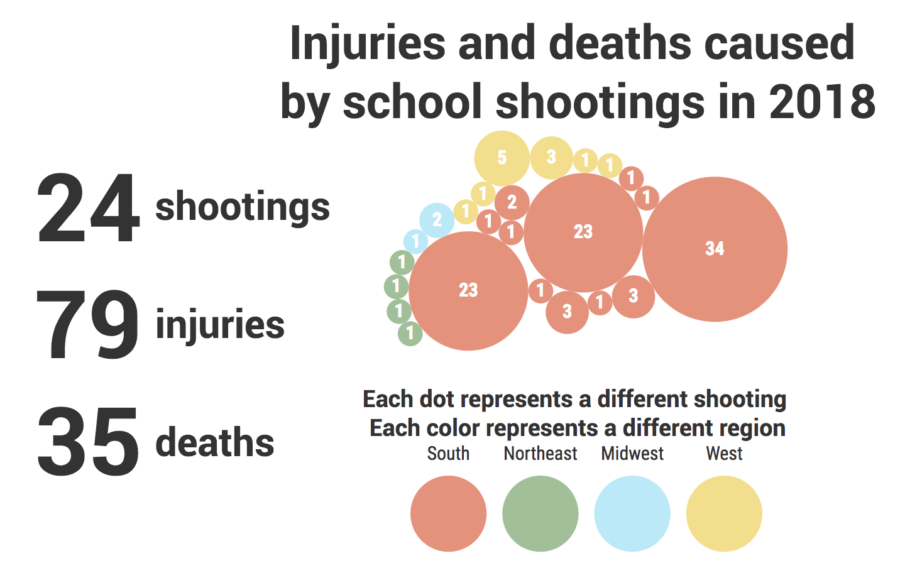Urban adopts new active shooter protocol
Infographic of deaths and injuries in school shootings in 2018, sorted by region. Source: Education Weekly. By Kian Nassre, Web Editor
In 2015, after a shooting at Los Angeles International Airport in 2013 where one Transportation Security Administration (TSA) officer died, the TSA released a video detailing the most effective ways to survive a shooting in a business or school. In the video, the TSA coined the catchphrase: Run, hide, fight. Since then, organizations and schools around the country have been adopting the new method. Now, Urban is doing the same.
Most schools, including Urban, had been using an outdated system for responding to an active shooter. The strategy was developed in Los Angeles after a series of drive-by shootings at schools in the area. Students and teachers at these schools were taught to stay still, remain silent, and remain out of view. Schools continue to employ this method, leading many to believe that this is the best way to remain safe during shootings. In fact, most schools still use this system, which is in reality only useful for drive-by shootings. But in 2006, the United States Department of Education released a study showing that quietly sheltering in place was not the most effective reaction during school shootings.
Charlotte Worsley, the Assistant Head for Student Life, led Urban’s efforts to implement a new active shooter drill. The Urban Safety Committee found a training run by a company named ALICE. The acronym ALICE stands for Alert Lockdown Inform Counter Evacuate. ALICE is a company that focuses on active shooter drills for individuals and groups from schools to families. ALICE was founded in response and after the Columbine shooting, in 1999. It was founded by Greg Crane, a former law enforcement officer and security consultant for more than 25 years.
At first, Urban sent just four people to do the ALICE training: Jennifer Epstein, Charlotte Worsley, Monique Perry, and David Coffman. “We did it, [and] we thought it was really good,” Worsley said. Urban then signed a three-year contract with the company. Urban’s faculty and staff have already completed the internet training part of the course, and the next step will include hosting an ALICE trainer for the public in March that three Urban teachers, as well as the school resource officer, Officer Granucci, will participate in.
The drill is composed of multiple steps that occur depending on the location of the shooter. The first step of the active shooter drill is to alert and inform people throughout the school with details of the shooter’s activity, including their location, appearance, and direction of movement. “The most important thing to do first is alert. The more information people have, the better they can save themselves,” Worsley said. After getting or giving information, the next step it to evacuate.
In an evacuation, individual classes and students would run from campus and meet at a set location far from the school. “The best thing to do is evacuate,” Worsley said. If evacuation isn’t possible because of the location of the shooter, barricading is the next best step.
“The idea of barricading yourself is giving yourself time to make a decision,” Worsley said. If barricading doesn’t work, the next step is called counter. Countering is based on the fact that “to shoot a gun, you need to be focused,” said Worsley, “[Countering] doesn’t mean going to find the shooter and tackling them, it just means being prepared if you have to face the shooter. Just start throwing things.” Throwing things breaks what’s called an OODA loop. An OODA loop is a cycle of focus that was developed by a United States Air Force Colonel, John Boyd. OODA stands for observe, orient, decide and act. Boyd applied the OODA loop to combat operations, but it can also be used to describe shooting a gun. If throwing something breaks the OODA loop, you and your peers have a better chance of surviving the attack.
Urban students and faculty have already practiced the part of the active shooter drill mandating that students barricade themselves in their classrooms, which is the lockdown part of ALICE. The next step toward practicing the entire drill is evacuation. The final step will be combining these actions, and the entire school will practice the full drill either this spring or next fall.
Schools are often the places where people learn how to enact drills for fires, earthquakes, and an active shooter situation that prepares them for the future. Worsley wants to continue practicing and perfecting the active shooter drill. In this age, things such as active shooter drills are becoming necessary. “It’s ridiculous. It’s ridiculous that I’m having to do this and that you’re having to do this. We should not be having to do this in school. But, if we’re going to have to do it, I’d rather do it enough that it does become instinctual,” Worsley said.


